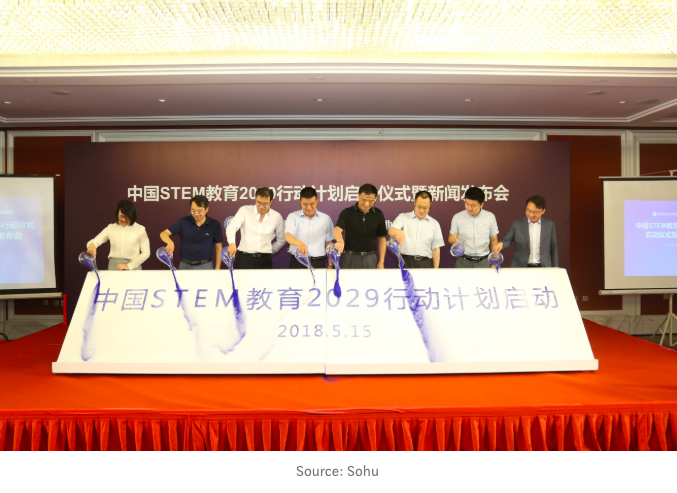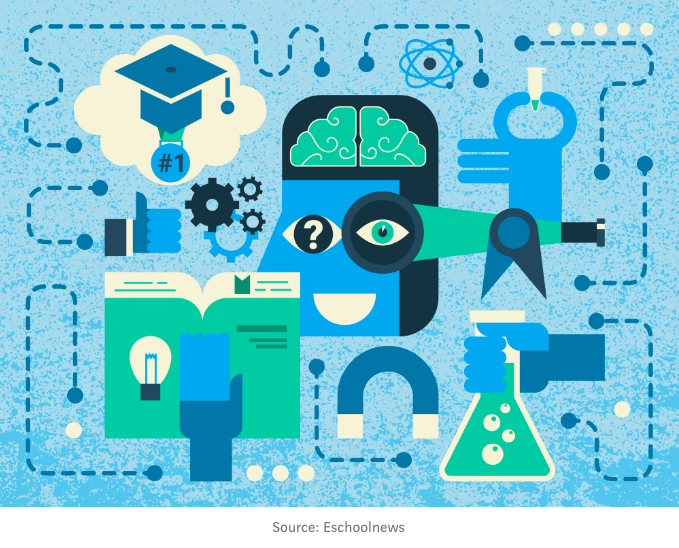The boom of STEM Education in China driven by the encouraging policy laid out by government, schools’ initiatives as well as parents’ awareness of preparing their kids to foster a well-rounded character is quite prominent in recent years. In this piece, we will look into how the major player Only Education initiated the implementation through their STEM subsidiary. Yet along with the boom also comes with some misunderstandings when applying the model in the school settings.
2029 Action Plan

In Feburary 2017, the Ministry of Education in China has announced to officially add STEM education into the primary school curriculum, which is the first official government recognition of STEM education. And later, in May 2018, the launching ceremony and press conference for the 2029 Action Plan for China’s STEM Education was held in Beijing, China. This plan aims to allow as many students to benefit from STEM education as possible and equip all students with scientific thinking and the ability to innovate. Among the highlights is the scientist-enterprise cooperation, which, through the cooperation between scientists and enterprises, can integrate resources, mobilize institutions, talents, devices, funds and projects, and promote scientific and technological innovation.
In response to encouraging policies by the government, schools in both public and private sectors around the country have begun to carry out STEM education programs. However, in order to effectively implement STEM curricula, full-time teachers specializing in STEM education and relevant contents to be taught are needed. At present, China lacks qualified STEM teachers and a training system is yet to be established. For example, with regard to the certification of new STEM teachers, there is no systematic admittance system.
The current market is like a bowl of mixed pea soup: there are tons of companies who provide or ‘claim’ to provide STEM education in China. However, there’s a huge disparity in terms of the qualities of these companies. In this regard, Only STEM has taken the lead.
Explorations of Only STEM

In response to changes in the market, Only Education has been experimenting various coping strategies, including contextualization of educational scenes and integration of the upstream and downstream of the industry chain of STEM education. As an offline STEM educational institution, Only STEM has opened nearly 40 chain stores, with a total number of students at 16,000, 70% of whom choose to continue studying at Only STEM after the first course. Centering on the STEM industry chain, Only Education has been actively expanding its contents and exploring STEM education models.
First, Only STEM began to offer online situational, animated courseware in early September 2018, which allows all educational contents to be presented in the form of cartoons. “Dr. Robin traveled back to the ancient age of dinosaurs and found that not far away a dinosaur was grazing leisurely while another looking for other animals for lunch.” This is part of a video clip for the course of “Dinosaur Archaeology”, serving as the introductory part of the whole teaching procedure. By contrast, the introduction used to be done by merely showing static, PowerPoint slides. In addition to upgrading educational content in characters and learning skills, Only STEM has also tried to improve the evaluation system and after-school system.
Secondly, Only STEM emphasizes the integration of curricula for preschool education and the application of theory to practice for primary education. Whether the courseware takes the form of cartoons or slides, the design principle of “scene-based teaching process” has not changed. The course for each semester is a big story, to the effect that in each class during the semester students would feel that they are experiencing the same event, exploring and taking challenges together with the cartoon characters. As a result, learning becomes a continuous, interesting process. Only STEM has now developed nearly 400 course subjects. For example, the course of “Adventures at Stanford” consists of 28 subjects.
At present, Only STEM has built a full range of curriculum framework for students between 3 and 12 years old, which can be roughly divided into kindergarten and primary school courses. It is reported that the focus of curriculum design will be adjusted according to the age group. While the kindergarten curriculum emphasizes integrating multi-dimensional abilities into the curriculum, the curriculum for primary schools emphasizes combining theory with practice. For example, in the course of “Dinosaur Archaeology”, students will complete the archaeological training with teaching aids such as bricks and hammers containing dinosaur fossils after they have formed a basic understanding of the differences between carnivorous and herbivorous dinosaurs, and then assemble fossil fragments into a complete dinosaur. In addition, the primary school curriculum requires that students be able to use sensors, kits and make parking poles, automatic waterers and other small inventions by programming.
In order to satisfy the needs of teaching tasks, Only STEM has begun to produce and customize teaching aids by itself, and now has more than 1600 kinds of teaching aids. Moreover, Only STEM has also started to set up a supply chain system to solve the problem of supplying standardized teaching aids.
Misunderstandings in China’s STEM Education

Along with the boom of STEM education comes with some misunderstandings, to which great importance must be attached by educational administrative departments and schools.
Misunderstanding 1: STEM education is nothing but skill training
STEM education pays attention to experiences and encourages students to make scientific inquiries in real situations, learning through experiment designing experiments, creative inventing and handcrafting, etc. However, the purpose of STEM education in primary and secondary schools is not to train “skilled craftsmen”, but to train “all-round, developed persons”, and STEM education must not be equated with skill training.
Misunderstanding 2: The form is more important than the scientific spirit
It must be admitted that STEM education disrupts the “classroom where students sit still”, encouraging students to learn by doing and playing, and to form a new learning style characterized by initiative, exploration, experience and creation. However, when carrying out STEM education, many schools attach too much importance to the forms of activities by deliberately developing an active classroom atmosphere, thus neglecting the scientific and rigorous nature of inquiring activities and resulting in superficial learning.
Misunderstanding 3: The learning result is more important than the learning process
Many schools tend to value success and avoid failure when implementing STEM education. Students are often observed to be cheering for the successful completion of a task, but once asked how to troubleshoot or why achieving a certain function is necessary, many cannot think of an answer. Therefore, the tendency of emphasizing results over processes in STEM education needs reversing so that students can form a correct understanding of true scientific spirit from an early age, which pays less attention to the final outcome and more to the process and methods of scientific inquiry, including whether the problem is justified, whether the researching scheme is reasonable, whether the logic is rigorous, and whether the conclusion is reliable, etc. as to help students construct their own scientific understanding and form a more perfect way of thinking.
Misunderstanding 4: Education is nothing but STEM education
Although STEM education is attracting attention from all walks of life, it is not all there is to education. With the increasing awareness of soft skills in China, more and more parents and children begin to recognize the important role of communication skills, empathy, business knowledge, leadership and other “soft skills” in personal growth. Well-off families in the first-tier cities like Shanghai hope that their children could develop in a healthy and happy way by pursuing and fulfilling their own ideals instead of studying to become an engineer; therefore, parents would be more willing to support their children to learn humanities and students would also be more motivated to.
These misunderstandings need to be tackled through more qualified STEM teachers, a well-developed training system and more relevant, systematic contents. Challenges on the other hand bring about opportunities. The fast-growing STEM market has entered a shuffle stage when international players could have a huge impact and opportunity to participate.



